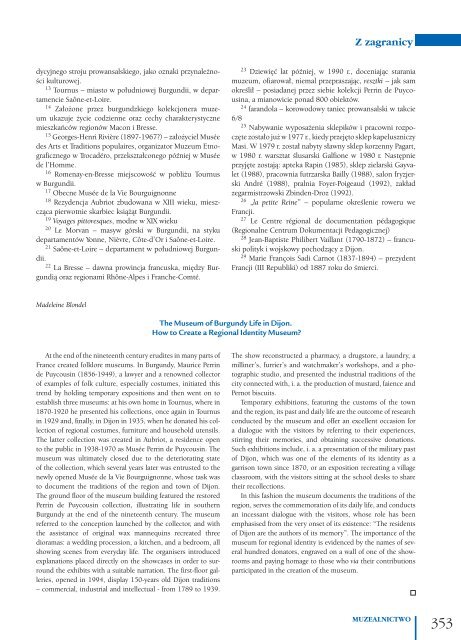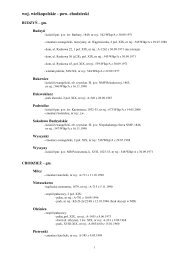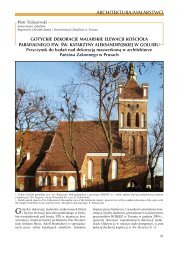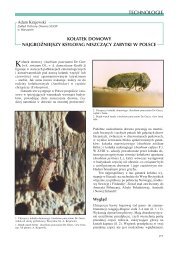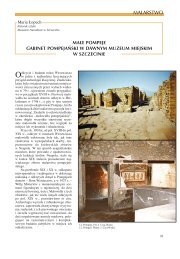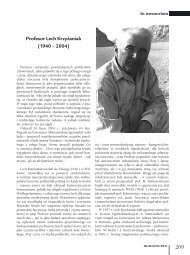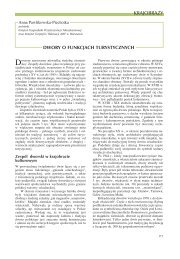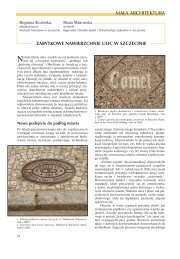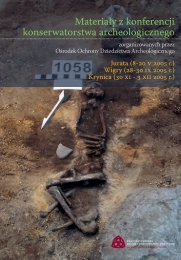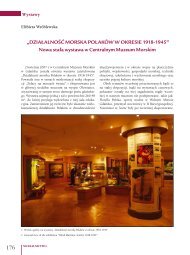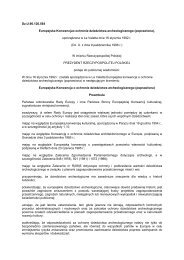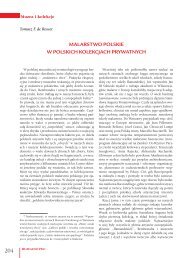muzeum życia burgundzkiego w dijon. jak stworzyć muzeum
muzeum życia burgundzkiego w dijon. jak stworzyć muzeum
muzeum życia burgundzkiego w dijon. jak stworzyć muzeum
Create successful ePaper yourself
Turn your PDF publications into a flip-book with our unique Google optimized e-Paper software.
dycyjnego stroju prowansalskiego, <strong>jak</strong>o oznaki przynależności<br />
kulturowej.<br />
13 Tournus – miasto w południowej Burgundii, w departamencie<br />
Saône-et-Loire.<br />
14 Założone przez <strong>burgundzkiego</strong> kolekcjonera <strong>muzeum</strong><br />
ukazuje życie codzienne oraz cechy charakterystyczne<br />
mieszkańców regionów Macon i Bresse.<br />
15 Georges-Henri Rivière (1897-1967?) – założyciel Musée<br />
des Arts et Traditions populaires, organizator Muzeum Etnograficznego<br />
w Trocadéro, przekształconego później w Musée<br />
de l’Homme.<br />
16 Romenay-en-Bresse miejscowość w pobliżu Tournus<br />
w Burgundii.<br />
17 Obecne Musée de la Vie Bourguignonne<br />
18 Rezydencja Aubriot zbudowana w XIII wieku, mieszcząca<br />
pierwotnie skarbiec książąt Burgundii.<br />
19 Voyages pittoresques, modne w XIX wieku<br />
20 Le Morvan – masyw górski w Burgundii, na styku<br />
departamentów Yonne, Nièvre, Côte-d’Or i Saône-et-Loire.<br />
21 Saône-et-Loire – departament w południowej Burgundii.<br />
22 La Bresse – dawna prowincja francuska, między Burgundią<br />
oraz regionami Rhône-Alpes i Franche-Comté.<br />
Madeleine Blondel<br />
At the end of the nineteenth century erudites in many parts of<br />
France created folklore museums. In Burgundy, Maurice Perrin<br />
de Puycousin (1856-1949), a lawyer and a renowned collector<br />
of examples of folk culture, especially costumes, initiated this<br />
trend by holding temporary expositions and then went on to<br />
establish three museums: at his own home in Tournus, where in<br />
1870-1920 he presented his collections, once again in Tournus<br />
in 1929 and, finally, in Dijon in 1935, when he donated his collection<br />
of regional costumes, furniture and household utensils.<br />
The latter collection was created in Aubriot, a residence open<br />
to the public in 1938-1970 as Musée Perrin de Puycousin. The<br />
museum was ultimately closed due to the deteriorating state<br />
of the collection, which several years later was entrusted to the<br />
newly opened Musée de la Vie Bourguignonne, whose task was<br />
to document the traditions of the region and town of Dijon.<br />
The ground floor of the museum building featured the restored<br />
Perrin de Puycousin collection, illustrating life in southern<br />
Burgundy at the end of the nineteenth century. The museum<br />
referred to the conception launched by the collector, and with<br />
the assistance of original wax mannequins recreated three<br />
dioramas: a wedding procession, a kitchen, and a bedroom, all<br />
showing scenes from everyday life. The organisers introduced<br />
explanations placed directly on the showcases in order to surround<br />
the exhibits with a suitable narration. The first-floor galleries,<br />
opened in 1994, display 150-years old Dijon traditions<br />
– commercial, industrial and intellectual - from 1789 to 1939.<br />
The Museum of Burgundy Life in Dijon.<br />
How to Create a Regional Identity Museum?<br />
Z zagranicy<br />
23 Dziewięć lat później, w 1990 r., doceniając starania<br />
<strong>muzeum</strong>, ofiarował, niemal przepraszając, resztki – <strong>jak</strong> sam<br />
określił – posiadanej przez siebie kolekcji Perrin de Puycousina,<br />
a mianowicie ponad 800 obiektów.<br />
24 farandola – korowodowy taniec prowansalski w takcie<br />
6/8<br />
25 Nabywanie wyposażenia sklepików i pracowni rozpoczęte<br />
zostało już w 1977 r., kiedy przejęto sklep kapeluszniczy<br />
Masi. W 1979 r. został nabyty sławny sklep korzenny Pagart,<br />
w 1980 r. warsztat ślusarski Galfione w 1980 r. Następnie<br />
przyjęte zostają: apteka Rapin (1985), sklep zielarski Gayvalet<br />
(1988), pracownia futrzarska Bailly (1988), salon fryzjerski<br />
André (1988), pralnia Foyer-Poigeaud (1992), zakład<br />
zegarmistrzowski Zbinden-Droz (1992).<br />
26 „la petite Reine” – popularne określenie roweru we<br />
Francji.<br />
27 Le Centre régional de documentation pédagogique<br />
(Regionalne Centrum Dokumentacji Pedagogicznej)<br />
28 Jean-Baptiste Philibert Vaillant (1790-1872) – francuski<br />
polityk i wojskowy pochodzący z Dijon.<br />
29 Marie François Sadi Carnot (1837-1894) – prezydent<br />
Francji (III Republiki) od 1887 roku do śmierci.<br />
The show reconstructed a pharmacy, a drugstore, a laundry, a<br />
milliner’s, furrier’s and watchmaker’s workshops, and a photographic<br />
studio, and presented the industrial traditions of the<br />
city connected with, i. a. the production of mustard, faience and<br />
Pernot biscuits.<br />
Temporary exhibitions, featuring the customs of the town<br />
and the region, its past and daily life are the outcome of research<br />
conducted by the museum and offer an excellent occasion for<br />
a dialogue with the visitors by referring to their experiences,<br />
stirring their memories, and obtaining successive donations.<br />
Such exhibitions include, i. a. a presentation of the military past<br />
of Dijon, which was one of the elements of its identity as a<br />
garrison town since 1870, or an exposition recreating a village<br />
classroom, with the visitors sitting at the school desks to share<br />
their recollections.<br />
In this fashion the museum documents the traditions of the<br />
region, serves the commemoration of its daily life, and conducts<br />
an incessant dialogue with the visitors, whose role has been<br />
emphasised from the very onset of its existence: “The residents<br />
of Dijon are the authors of its memory”. The importance of the<br />
museum for regional identity is evidenced by the names of several<br />
hundred donators, engraved on a wall of one of the showrooms<br />
and paying homage to those who via their contributions<br />
participated in the creation of the museum.<br />
MUZEALNICTWO<br />
353


